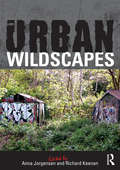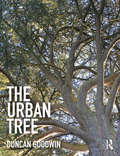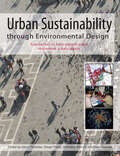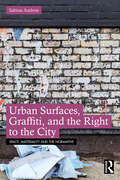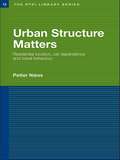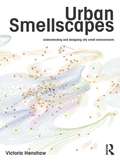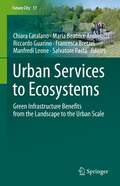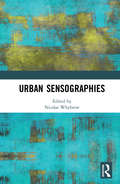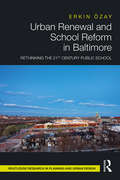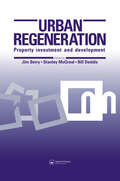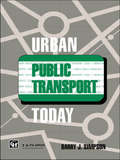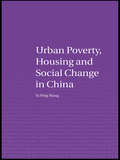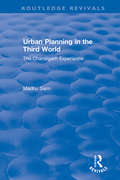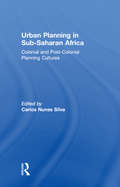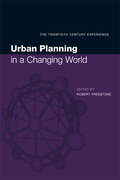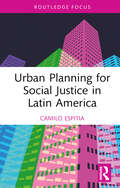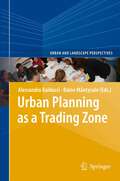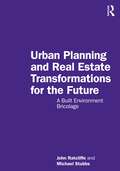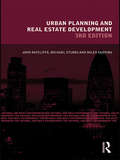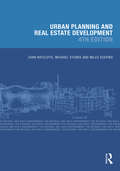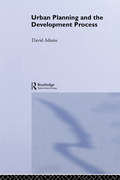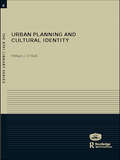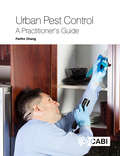- Table View
- List View
Urban Wildscapes
by Anna Jorgensen Richard KeenanUrban Wildscapes is one of the first edited collections of writings about urban ‘wilderness’ landscapes. Evolved, rather than designed or planned, these derelict, abandoned and marginal spaces are frequently overgrown with vegetation and host to a wide range of human activities. They include former industrial sites, landfill, allotments, cemeteries, woods, infrastructural corridors, vacant lots and a whole array of urban wastelands at a variety of different scales. Frequently maligned in the media, these landscapes have recently been re-evaluated and this collection assembles these fresh perspectives in one volume. Combining theory with illustrated examples and case studies, the book demonstrates that urban wildscapes have far greater significance, meaning and utility than is commonly thought, and that an appreciation of their particular qualities can inform a far more sustainable approach to the planning, design and management of the wider urban landscape. The wildscapes under investigation in this book are found in diverse locations throughout the UK, Europe, China and the US. They vary in scale from small sites to entire cities or regions, and from discrete locations to the imaginary wildscapes of children’s literature. Many different themes are addressed including the natural history of wildscapes, their significance as a location for all kinds of playful activity, the wildscape as ‘commons’ and the implications for landscape architectural practice, ranging from planting interventions in wildscapes to the design of the urban public realm on wildscape principles.
The Urban Tree
by Duncan GoodwinThere is a growing evidence base that documents the social, environmental and economic benefits that urban trees can deliver. Trees are, however, under threat today as never before due to competition for space imposed by development, other hard infrastructures, increased pressure on the availability of financial provision from local authorities and a highly cautious approach to risk management in a modern litigious society. It is, therefore, incumbent upon all of us in construction and urban design disciplines to pursue a set of goals that not only preserve existing trees where we can, but also ensure that new plantings are appropriately specified and detailed to enable their successful establishment and growth to productive maturity. Aimed at developers, urban planners, urban designers, landscape architects and arboriculturists, this book takes a candid look at the benefits that trees provide alongside the threats that are eliminating them from our towns and cities. It takes a simple, applied approach that explores a combination of science and practical experience to help ensure a pragmatic and reasoned approach to decision-making in terms of tree selection, specification, placement and establishment. In this way, trees can successfully be incorporated within our urban landscapes, so that we can continue to reap the benefits they provide.
Urban Sustainability Through Environmental Design: Approaches to Time-People-Place Responsive Urban Spaces
by Kevin Thwaites Sergio Porta Ombretta Romice Mark GreavesWhat can architects, landscape architects and urban designers do to make urban open spaces, streets and squares, more responsive, lively and safe? Urban Sustainability through Environmental Design answers this question by providing the analytical tools and practical methodologies that can be employed for sustainable solutions to the design and management of urban environments. The book calls into question the capability of ‘quick-fix’ development solutions to provide the establishment of fixed communities and suggests a more time-conscious and evolutionary approach. This is the first significant book to draw together a pan-European view on sustainable urban design with a specific focus on social sustainability. It presents an innovative approach that focuses on the tools of urban analysis rather than the interventions themselves. With its practical approach and wide-ranging discussion, this book will appeal to all those involved in producing communities and spaces for sustainable living, from students to academics through to decision makers and professional leaders.
Urban Surfaces, Graffiti, and the Right to the City (ISSN)
by Sabina AndronThis book explores the ownersheir authorship and management, and their role in struggles for the right to the city. Includes a critical history of graffiti and street art as contested surface discourses. Interdisciplinary appeal.
Urban Structure Matters: Residential Location, Car Dependence and Travel Behaviour (RTPI Library Series)
by Petter NaessGoing beyond previous investigations into urban land use and travel, Petter Næss presents new research from Denmark on residential location and travel to show how and why urban spatial structures affect people's travel behaviour. In a comprehensive case study of the Copenhagen metropolitan area, Næss combines traditional quantitative travel surveys with qualitative interviews in order to identify the more detailed mechanisms through which urban structure affects travel behaviour. The case study findings are compared with those from other Nordic countries and analyzed and evaluated in the light of relevant theory and literature to provide solid, valuable conclusions for planning sustainable urban development. With a broader range of statistics than previous studies and conclusions of international relevance, Urban Structure Matters provides well-grounded conclusions for how spatial planning of urban areas can be used to reduce car dependence and achieve a more sustainable development of cities.
Urban Smellscapes: Understanding and Designing City Smell Environments
by Victoria HenshawWe see the city, we hear the city, but above all: we smell the city. Scent has unique qualities: ubiquity, persistence, and an unparalleled connection to memory, yet it has gone overlooked in discussions of sensory design. What scents shape the city? How does scent contribute to placemaking? How do we design smell environments in the city? Urban Smellscapes makes a notable contribution towards the growing body of literature on the senses and design by providing some answers to these questions and contributing towards the wider research agenda regarding how people sensually experience urban environments. It is the first of its kind in examining the role of smell specifically in contemporary experiences and perceptions of English towns and cities, highlighting the perception of urban smellscapes as inter-related with place perception, and describing odour’s contribution towards overall sense of place. With case studies from factories, breweries, urban parks, and experimental smell environments in Manchester and Grasse, Urban Smellscapes identifies processes by which urban smell environments are managed and controlled, and gives designers and city managers tools to actively use smell in their work.
Urban Services to Ecosystems: Green Infrastructure Benefits from the Landscape to the Urban Scale (Future City #17)
by Chiara Catalano Maria Beatrice Andreucci Riccardo Guarino Francesca Bretzel Manfredi Leone Salvatore PastaThe aim of this book is to bring together multidisciplinary research in the field of green infrastructure design, construction and ecology. The main core of the volume is constituted by contributions dealing with green infrastructure, vegetation science, nature-based solutions and sustainable urban development. The green infrastructure and its ecosystem services, indeed, are gaining space in both political agendas and academic research. However, the attention is focused on the services that nature is giving for free to and for human health and survival. What if we start to see things from another perspective? Our actions shall converge for instance to turn man-made environment like cities from heterotrophic to autotrophic ecosystems. From landscape ecology to urban and building design, like bricks of a wall, from the small scale to the bigger landscape scale via ecological networks and corridors, we should start answering these questions: what are the services that are we offering to Nature? What are we improving? How to implement our actions? This book contains three Open Access chapters, which are licensed under the terms of the Creative Commons Attribution 4.0 International License (CC BY 4.0).
Urban Sensographies
by Nicolas WhybrowUrban Sensographies views the human body as a highly nuanced sensor to explore how various performance-based methods can be implemented to gather usable ‘felt data’ about the environment of the city as the basis for creating embodied mappings. The contributors to this fascinating volume seek to draw conclusions about the constitution, character and morphology of urban space as public, habitable and sustainable by monitoring the reactions of the human body as a form of urban sensor. This co-authored book is centrally concerned, as a symptom of the degree to which cities are evolving in the 21st century, to examine the effects of this change on the practices and behaviours of urban dwellers. This takes into account such factors as: defensible, retail and consumer space; legacies of modernist design in the built environment; the effects of surveillance technologies, motorised traffic and smart phone use; the integration of ‘wild’ as well as ‘domesticated’ nature in urban planning and living; and the effects of urban pollution on the earth’s climate. Drawing on three years of funded practical research carried out by a multi-medial team of researchers and artists, this book analyses the presence and movement of the human body in urban space, which is essential reading for academics and practitioners in the fields of dance, film, visual art, sound technology, digital media and performance studies.
The Urban Section: An analytical tool for cities and streets
by Robert ManthoThe design of streets, and the connections between streets of different character, is the most important task for architects and urbanists working in an urban context. Considered at two distinct spatial scales – that of the individual street – the Street Section – and the complex of city streets – the City Transect – Urban Section identifies a range of generic street types and their success or otherwise in responding to climatic, cultural, traditional, morphological, social and economic well being. Using comparative studies a profile of best practice in street and city design is identified, showing methodologies in both the analysis of, and design for, successful streets and public places – place-making. In uniquely dealing with both the historic and contemporary description and analysis of urban ‘streets’ around the world, the work is of both academic and professional interest to architects, urban planners and designers, highway engineers, landscape and urban design advisers in both the public and private sectors; students, amenity and civic societies, city authorities and government agencies.
Urban Renewal and School Reform in Baltimore: Rethinking the 21st Century Public School
by Erkin ÖzayUrban Renewal and School Reform in Baltimore examines the role of the contemporary public school as an instrument of urban design. The central case study in this book, Henderson-Hopkins, is a PK-8 campus serving as the civic centerpiece of the East Baltimore Development Initiative. This study reflects on the persistent notions of urban renewal and their effectiveness for addressing the needs of disadvantaged neighborhoods and vulnerable communities. Situating the master plan and school project in the history and contemporary landscape of urban development and education debates, this book provides a detailed account of how Henderson-Hopkins sought to address several reformist objectives, such as improvement of the urban context, pedagogic outcomes, and holistic well-being of students. Bridging facets of urban design, development, and education policy, this book contributes to an expanded agenda for understanding the spatial implications of school-led redevelopment and school reform.
Urban Regeneration: Property Investment and Development
by Stanley McGreal Jim Berry Bill DeddisThis book provides an in-depth analysis of the role of property investment and development in the urban regeneration process. It relates the physical, economic, financial and environmental aspects of urban change and development to the realities of particular cities by case studies drawn from Britain and Europe.
Urban Public Transport Today
by Dr Barry Simpson B. SimpsonThis book is about how local public transport can be made a less unacceptable alternative to the private car than it is now. It is intended for officials, politicians and others interested in the land use/local transport conundrum. It is also valuable to town planners, those working for passenger transport authorities and anyone concerned with policy making and project appraisal for local public transport.
Urban Poverty, Housing and Social Change in China (Housing and Society Series)
by Ya Ping WangEconomic reform in China has resulted in a widening gap between the rich and the poor, and urban poverty has emerged as a key factor which may affect future development. This new book examines the poverty problem in relation to housing and social changes in large inland cities, and assesses the effectiveness of recent government anti-poverty policies. The book also puts the Chinese experience in the wider context of transitional economies and discusses the similarities and differences between China and Central and Eastern European countries. The book is based on a long period of research on Chinese urban development, and benefited from several research projects conducted in Chinese cities. It is an important reference for all of those interested in housing, urban studies and social change, and is a key text for students of the Chinese economy and society.
Urban Planning in the Third World: The Chandigarh Experience (Routledge Revivals)
by Madhu SarinOriginally published in 1982 Urban Planning in the Third World is concerned with some of the critical issues underlying urban planning in the Third World. Taking the specific case of Chandigarh, planned or rather ‘designed’ by Le Corbusier as the new capital of Punjab following Partition, the author describes the development of the city, showing how concepts inherent in the master plan and the policies pursued in its implementation not merely ignored, but totally excluded a major section of the population from ‘legal’ housing and employment. The book sets a distinct theoretical framework, examining the Indian context at the time of Independence, the Western origins of the planning concepts applied in the city, and the process by which Le Corbusier finalized its master plan in a matter of days. The book also examines the social forces determining the temporary resolution of inherent conflicts in the plan and examines the growth of non-plan settlements in the city and the impact of the plan on the lives of the settlement residents.
Urban Planning in Sub-Saharan Africa: Colonial and Post-Colonial Planning Cultures
by Carlos Nunes SilvaCities in Sub-Saharan Africa are unequally confronted with social, economic and environmental challenges, particularly those related with population growth, urban sprawl, and informality. This complex and uneven African urban condition requires an open discussion of past and current urban planning practices and future reforms. Urban Planning in Sub-Saharan Africa gives a broad perspective of the history of urban planning in Sub-Saharan Africa and a critical view of issues, problems, challenges and opportunities confronting urban policy makers. The book examines the rich variety of planning cultures in Africa, offers a unique view on the introduction and development of urban planning in Sub-Saharan Africa, and makes a significant contribution against the tendency to over-generalize Africa’s urban problems and Africa’s urban planning practices. Urban Planning in Sub-Saharan Africa is written for postgraduate students and advanced undergraduates, researchers, planners and other policy makers in the multidisciplinary field of Urban Planning, in particular for those working in Spatial Planning, Architecture, Geography, and History.
Urban Planning in a Changing World: The Twentieth Century Experience (Studies In History, Planning, And The Environment)
by FreestoneUrban planning in today's world is inextricably linked to the processes of mass urbanization and modernization which have transformed our lives over the last hundred years. Written by leading experts and commentators from around the world, this collection of original essays will form an unprecedented critical survey of the state of urban planning a
Urban Planning for Social Justice in Latin America
by Camilo EspitiaUrban Planning for Social Justice in Latin America explores how urban planning can be used as a tool for social equity. The book examines several Latin American cities, each with specific challenges, and explores how they have gradually overcome these difficulties through policies, planning, and design, and with private/public sector coordination. The cases include: The built environment and social mobility in Bogotá; Mexico City and its difficulties with water scarcity; Addressing air quality and environmental justice in Lima; Santiago de Chile’s energy consumption and carbon footprint; Buenos Aires and the issue of urban agriculture and food security; Connectivity as a social transformation device in Medellín. The book goes beyond simply identifying the challenges and explains some of the practical day-to-day planning efforts, including interviews with staff from those municipalities, illustrations, and strategies that have been successful. As a result, this book will be helpful to planners in the region, as well as outside Latin America, because it demonstrates how fruitful results can be achieved in areas typically perceived as underdeveloped. Although based on research and data, this book offers a positive perspective on the possibilities rather than the limitations, hoping to inspire new generations of planners to pursue careers in search of social change.
Urban Planning as a Trading Zone
by Raine Mäntysalo Alessandro Balducci'Trading zone' is a concept introduced by Peter Galison in his social scientific research on how scientists representing different sub-cultures and paradigms have been able to coordinate their interaction locally. In this book, Italian and Finnish planning researchers extend the use of the concept to different contexts of urban planning and management, where there is a need for new ideas and tools in managing the interaction of different stakeholders. The trading zone concept is approached as a tool in organizing local platforms and support systems for planning participation, knowledge production, decision making and local conflict management. In relation to the former theses of communicative planning theory that stress the ideals of consensus, mutual understanding and universal reason, the 'trading zone approach', outlined in this book, offers a different perspective. It focuses on the potentiality to coordinate locally the interaction of different stakeholders without requiring the deeper sharing of understandings, values and motives between them. Galison's commentary comes in the form of the book's final chapter.
Urban Planning and Real Estate Transformations for the Future: A Built Environment Bricolage
by John Ratcliffe Michael StubbsThis book presents fresh ways of thinking about the future for all those involved in conceiving, planning, designing, funding, constructing, occupying and managing the built environment, to face the challenges, and grasp the opportunities, that lie ahead over the next few decades. Four major themes form the basis of the volume: (1) Future Awareness and a New Sense of Place. (2) Global Governance and Anticipatory Leadership. (3) Innovation, Reform and Exemplars. (4) Urban Planning and Real Estate Transformations. Within these structural themes are a diverse range of 'Discourses' addressing many of the big questions and driving forces that face us, together with a proposed methodology (Strategic Foresight) and an array of practical illustrations viewing what can be done today – whether by organisations, individuals, cities or communities – to positively shape a preferred future and manipulate us towards achieving it. It will be important reading for students, practitioners, agencies and corporations across the built environment, especially in the fields of urban planning, real estate development, architecture, civil engineering and construction.
Urban Planning and Real Estate Transformations for the Future: A Built Environment Bricolage
by John Ratcliffe Michael StubbsThis book presents fresh ways of thinking about the future for all those involved in conceiving, planning, designing, funding, constructing, occupying and managing the built environment, to face the challenges, and grasp the opportunities, that lie ahead over the next few decades. Four major themes form the basis of the volume:(1) Future Awareness and a New Sense of Place.(2) Global Governance and Anticipatory Leadership. (3) Innovation, Reform and Exemplars. (4) Urban Planning and Real Estate Transformations. Within these structural themes are a diverse range of 'Discourses' addressing many of the big questions and driving forces that face us, together with a proposed methodology (Strategic Foresight) and an array of practical illustrations viewing what can be done today – whether by organisations, individuals, cities or communities – to positively shape a preferred future and manipulate us towards achieving it. It will be important reading for students, practitioners, agencies and corporations across the built environment, especially in the fields of urban planning, real estate development, architecture, civil engineering and construction.
Urban Planning and Real Estate Development (Natural and Built Environment Series)
by John Ratcliffe Michael Stubbs Miles KeepingThe twin processes of planning and property development are inextricably linked – it’s not possible to carry out a development strategy without an understanding of the planning process, and equally planners need to know how real estate developers do their job. This third edition of Urban Planning and Real Estate Development guides students through the procedural and practical aspects of developing land from the point of view of both planner and developer. The planning system is explained, from the increasing emphasis on spatial planning at a regional level down to the detailed perspective of the development control process and the specialist requirements of historic buildings and conservation areas. At the same time the authors explain the entire development process from inception through appraisal, valuation and financing to completion and disposal. This is an invaluable textbook for real estate and planning students, and helps to meet the requirements of the RICS and RTPI Assessment of Professional Competence.
Urban Planning and Real Estate Development (Natural and Built Environment Series)
by John Ratcliffe Michael Stubbs Miles KeepingThis fourth edition of Urban Planning and Real Estate Development guides readers through the procedural and practical aspects of developing land from the point of view of both planner and developer. The twin processes of planning and property development are inextricably linked – it is not possible to carry out a development strategy without an understanding of the planning process, and, equally, planners need to know how real estate developers do their job. The planning system is explained, from the increasing emphasis on spatial planning at a national, local, and neighbourhood level down to the detailed perspective of the development management process and the specialist requirements of historic buildings and conservation areas. At the same time, the authors explain the entire development process from inception, through appraisal, valuation, and financing, to completion. Sustainability and corporate social responsibility and their impact on planning and development are covered in detail, and the future consequences of the COVID-19 pandemic are explored in new opening and closing chapters setting the text in a global context. Written by a team of authors with many years of academic, professional, and research experience, and illustrated throughout with practical case studies and follow-up resources, this book is an invaluable textbook for real estate and planning students and helps to meet the requirements of the RICS and RTPI Assessment of Professional Competence.
Urban Planning And The Development Process
by David AdamsThis text is about the very essence of urban planning in a market economy. It is concerned with people - landowners, developers, investors, politicians and ordinary members of the public - who produce change in towns and cities as they relate to each other and react to development Pressure. Whether Such Change Occurs Slowly And Is Almost Unnoticed, Or happens rapidly and is highly disruptive, a production process is creating a finished product: the built environment. This form of production, known as the land and property development process, is regulated but not controlled by the state. Urban planning is therefore best considered as one form of state intervention in the development process.; Since urban planning would have no legitimate basis without state power, it is an inherently political activity, able to alter the distribution of scarce environmental resources. Through doing so, it seeks to resolve conflicts of interest over the use and development of land. However, urban plans that appear to favour particular interests such as house-builders above others such as community groups provoke intense controversy. Development planning can thus become highly politicized, with alliances and divisions between politicians not always explained by traditional party politics.; These issues are explored with particular reference to statutory plan-making at the local level. The author draws on his extensive research into urban planning and development, making use of recent case studies and examples to illustrate key points. There are four parts. The first explores the operation of land and property markets and development processes, and examines how the state intervenes in the form of urban planning. The second part looks at the people and organizations who play a critical role in shaping the built environment and considers their relationship with the planning system. Specific attention is paid to important actors in the development process, such as landowners, developers, financial institutions, professional advisers and to the variety of agencies in the public sector that aim to promote development. This concludes with discussion of public- private partnerships and growth coalitions. The third part of the book concentrates on local development planning.
Urban Planning and Cultural Identity (RTPI Library Series #Vol. 6)
by William NeillUrban Planning and Cultural Identity reviews the intense spatiality of conflict over identity construction in three cities where culture and place identity are not just post-modernist playthings but touch on the raw sensibilities of who people define themselves to be. Berlin as the reborn German capital has put 'coming to terms with' the Holocaust and the memory of the GDR full square at the centre of urban planning. Detroit raises questions about the impotence and complicity of planners in the face of the most extreme metropolitan spatial apartheid in the United States and where African-American identity now seems set on a separatist course. In Belfast, in the clash of Irish nationalist and Ulster unionist traditions, place can take on intense emotional meanings in relation to which planners as 'mediators of space' can seem ill equipped.The book, drawing on extensive interview sources in the case study cities, poses a question of broad relevance. Can planners fashion a role in using environmental concerns such as Local Agenda 21 as a vehicle of building a sense of common citizenship in which cultural difference can embed itself?
Urban Pest Control: A Practitioner Guide
by Partho DhangThis guide brings together the varied and multiple skills and activities required of pest control practitioners, including biology, chemistry, architecture, engineering, sales, logistics, legal and accounting, presented with a primary emphasis on pest organisms at its core. This book provides information and tips on all of these aspects and explores the business of controlling pests (including trends in the industry, pest control tools, and sustainable pest control); covers biological information on each pest in addition to information on control and management, monitoring and follow-up; focuses particularly on globally significant pests with internationally-applicable use and guidance; and provides practical and hands-on experience, drawing on original case studies. This is a key resource for pest control practitioners, as well as in-house staff of companies or buildings involved in household or urban pest control. It is also a valuable reference for researchers, and sanitation and building managers.
